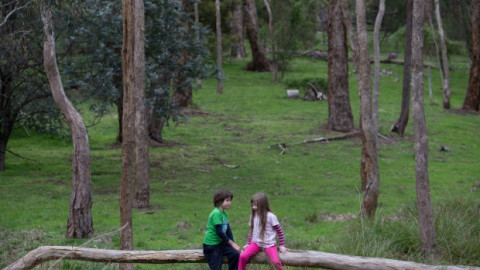
Thomas and his little sister Sarah have the same disability. They were both diagnosed with autism when they were four and attended the same early intervention service. But when it came time to start school, only Thomas qualified for disability funding. Sarah did not meet the criteria because she pronounced words too clearly, despite struggling to understand them.
Parents Paul Coleman and Annie Walton spent a year "jumping through hoops" to get an integration aid for Thomas, who is now 9.
"You have to paint the worst case scenario for your child to prove they need funding," Mr Coleman said.
"We were called into meetings and spent hours talking about how bad Thomas would be and how he would not be able to function in society. No parent wants to do that."
Thomas will have to reapply for funding when he goes to high school.
"We will have to go through the ordeal again even though autism is an ongoing thing," Mrs Walton said. "It stays with them for life."
The Hurstbridge family's frustrations with the Program for Students with Disabilities will be familiar to many parents. The program, which is being reviewed as part of an Andrews' government pre-election promise, provides additional funding to Victorian state schools to help them support disabled students.
In a submission to the review, the Victorian Council of Social Service warned that too many disabled students were missing out on vital support in schools because they fell outside the program's restrictive criteria.
While the current program helps around 4 per cent of Victorian students, around 20 per cent of students have additional health and development needs.
The council's acting chief executive Mary Sayers said the program's rigid criteria should be replaced with an educational needs-based model that supports all students with additional health and developmental needs.
"There needs to be much more of a focus on having high expectations of students with a disability rather than low expectations," she said.
She also called for more training for teachers to help them support disabled students, and more transparency around how funding was spent.
The council's submission said some schools discouraged disabled students from enrolling because of concerns the schools would not receive funding to support them. Other schools spent funds earmarked for disabled students on Lego and martial arts training for teachers to help them manage challenging behaviours, it says.
It highlighted serious incidents of bullying, expulsion and concerns about the use of restraint and seclusion to manage students' behaviour. The submission said students with acquired brain injuries were generally unable to access the scheme unless they had another disability.
Australia's former Disability Discrimination Commissioner, Dr Graeme Innes, is leading the review, which will make recommendations to the state government in November. It will focus on the needs of students with autism and dyslexia and the transition from primary to secondary schools.
A spokesman for Education Minister James Merlino said the review would help the government improve the current funding model to "maximise the learning opportunities and well-being of children with a disability."